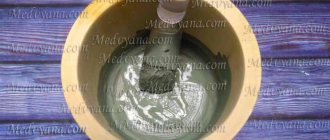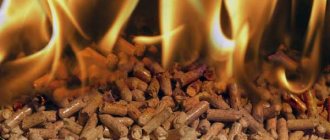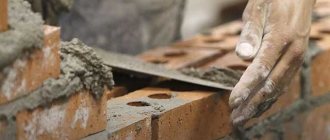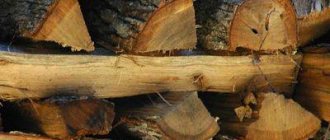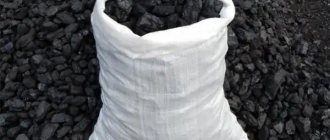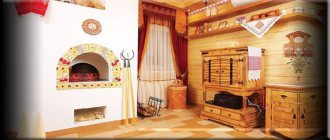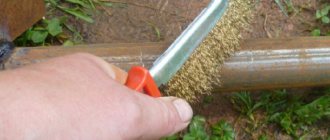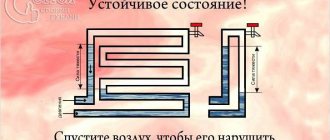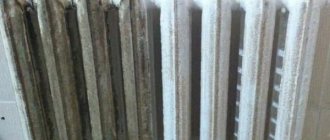What parameters are affected by the mixture for laying bricks?
A mixture of poor quality or inappropriate for operating conditions can cause very unpleasant consequences. The stove will either have to be constantly repaired, or completely redone taking into account the mistakes made.
The quality of the solution affects the safe operation of the furnace
How does a poor-quality masonry mixture manifest itself?
- Cracks in masonry joints. They are most quickly detected in places of maximum heating. The presence of cracks indicates that the strength of the furnace has decreased significantly.
- Smoke enters the room. A very dangerous phenomenon that requires immediate elimination. In winter, the stove is not dismantled; cracks have to be periodically sealed with mortar throughout the season. After a few days it falls out and the process needs to be repeated.
- The bricks are shaking. Such consequences are found near the firebox doors. Heavy cast iron structures are connected to bricks. If they are not strong enough, then the doors will wobble a lot when opening/closing. With such a problem, you can hold on to the heat, but you need to use the firebox very carefully and carefully.
If you use a low-quality solution, you will subsequently have to repair cracks in the slab
Clay-sand mortar
Used for guardianship, indoor chimney, fluff. You can also place a furnace on it if the oven is low or medium temperature.
Advantages:
- The material is inexpensive, and in some cases it can be obtained for free;
- Environmentally friendly;
- Heat-resistant and heat-resistant;
- Plastic.
Disadvantages - long preparation of materials for use, use in low or medium heating stoves, or only in the “body” of the stove, excluding the firebox.
Choosing sand
You can buy sand at a hardware store or get it yourself. It is necessary to use river (alluvial) or quarry (medium-grained), cleared of dust and debris using the method of sifting through a sieve, with a hole diameter of at least 1.5 mm. However, even sifting often does not prevent the presence of impurities that impair the quality of the future solution, so additional processing is required.
For this:
- Take a pipe approximately 2 cm in diameter and 6 cm long. You can also use a regular plastic drinks bottle.
- A hose is connected to the bottom of the pipe, and the cavity is filled with sand by about a third.
- Provide water supply through the hose so that the sand is not washed out, and dirty water with floating impurities overflows the edges of the tube or bottle.
- The procedure lasts until the water is almost clear.
- The sand needs to be dried by laying it on a clean film.
Choosing clay
Clay is a material consisting of the mineral kaolinite. You can get it on your own site or ask one of the local residents who recently dug a hole for any purpose.
Regular clay can also be purchased at the store. It is sold packaged in hermetically sealed bags. However, this does not mean that it can be immediately used in masonry. Before doing this, be sure to sift it through a sieve and determine the fat content using the method described below.
The upper layer of clay deposits is usually mixed with earth and other impurities undesirable in the masonry with poor adhesion. The optimal choice is considered to be a layer of clay deposits from a depth of 2-3 meters.
However, these are not all the criteria for selection. Clay that is too thin will be crumbly; clay that is too oily will crack and shrink when dried. You can determine whether the material in front of you is suitable by trial and error.
- Roll 2 balls from wet clay, approximately 5 cm in diameter.
- Crumple one into a flat cake, and leave the other as is.
- Let the samples dry in natural conditions, without access to heat, wind or precipitation.
- After 3 days, inspect them. If cracks appear on the cake or ball, it means the clay is oily and you should take either another one or deplete it by adding more sand when making the solution.
- The ball must be thrown onto the floor from a height of 1 meter. If it breaks, the material contains a lot of organics and unnecessary impurities. Ideally, it should completely retain its shape.
Mix the solution
Material proportions:
- Oily clay/sand - 1/2;
- Suitable clay/sand - 1/1.
It is believed that “skinny” clay can be used by reducing the amount of sand added to it. In practice, these actions are ineffective; it will still not have good adhesion.
The preparation procedure is as follows:
- To prepare the solution, pour the clay into a clean container and add a little clean water. Stir and leave for 2 days to soak, stirring occasionally.
- Rub the solution through a sieve with 2–3 mm mesh.
- Add sand in the proportion indicated above and stir. Pour in the water gradually, the consistency is standard - “thick sour cream”. The solution is homogeneous; it should slide off the trowel smoothly, and not fall or stick.
Previously, salt was added to the mixture for laying the stove. This was done with the aim of expelling evil spirits from the hearth. Later, people forgot why they put salt in; there was a common misconception that it increases the strength of the solution. In fact, other than efflorescence on the surface, which you will have to scrub off the brick every day for years, you will not get anything good from such experiments.
Recommended mixtures for laying a stove
The list does not include compositions with cement and gypsum. Now you understand that this is the worst option.
Table. Types of masonry mixtures for brick ovens
| Type of mixture | Brief description of physical and operational characteristics |
| Ready-made formulations | Modern mixtures include fireclay clay powder, sand and plasticizers. They are sold in bags, are easy to prepare, and perform their tasks very effectively. The only drawback is the relatively high cost. But stoves do not require a lot of mixture; the price of the solution does not have a noticeable impact on the cost of the facility. |
| They do it themselves. The master must have extensive practical experience to correctly select clay and sand, determine the optimal formulation, etc. This is a traditional solution, if the recommendations are followed, it fully meets the existing requirements of government regulations. As for the performance characteristics, they satisfy users in all respects. |
As an example, we will consider the process of preparing a mixture from ordinary clay.
Types of ready-made mixtures for laying stoves
Prices for fireproof mortar for stoves and fireplaces
Fireproof mortar for stoves and fireplaces
How to prepare a mortar for laying a stove
To construct a kiln, the proportions of the introduced ingredients are determined experimentally depending on the fat content of the clay. The following types are distinguished:
- Oily
- characterized by plasticity, but becomes covered with cracks when moisture evaporates. - Skinny
is not plastic, has low strength, and crumbles when dried. - Normal
- when hardening, it changes slightly in volume, is plastic, does not crack.
Prepare mortar for laying clay-based stoves following the following algorithm:
- sift the sand on a sieve with a mesh size of 1.5 mm;
- wash the sand;
- grind the clay, pour it into a bucket, fill it with water;
- change the water, mixing with the clay, until it reaches a paste-like consistency and is completely washed;
- add sand to the clay, maintaining a ratio of 1:2;
- stir evenly;
- add, if necessary, salt in an amount of 0.1–0.25 kg and cement (0.75 kg) per bucket of mixture to increase strength.
Make a sand-cement mixture by mixing sand and cement in a ratio of 2:1 or 3:1, add water to the required consistency. The lime composition is prepared in a similar way. Slaked lime is mixed with sand (1:2 or 1:3). The proportion is affected by the consistency of the lime. To increase strength, asbestos can be added in a volume of 10% of the amount of clay.
The preparation of a refractory mixture is made by adding fireclay, which is mixed with clay in equal proportions. Water is added in an amount of 25% by weight of the clay. The ingredients are mixed to a plastic consistency.
It is advisable to experimentally determine the ratio of components and then prepare the full volume. When determining the need for materials, remember that for 50 bricks you will need two buckets of masonry mixture.
Practical tips for using the mixture
If you violate the generally accepted rules for laying stoves, then even with very high-quality mixtures you can get an outright defect. What do the professionals advise?
The quality of the furnace masonry depends not only on the mortar
- The clay should only be mixed with a special mixer; you can never achieve a homogeneous composition manually.
- The solution can be left for an unlimited amount of time. After drying, water is added and the composition is mixed. This cannot be done with cement-based solutions; once they harden, they cannot be corrected.
- Work is allowed only at temperatures not lower than +10°C. The bricks must be dry; the rate of moisture absorption does not affect the strength parameters.
- The first time the stove can be lightly heated no earlier than three days after the completion of the masonry. It is strictly not recommended to rush; if the recommendations are not followed, large cracks may appear through which smoke enters the room.
- To lay the outer row of the outer chimney, cement should be added to the mixture. Ordinary clay with sand is afraid of moisture and gradually erodes outdoors. Cement mortar does not react to the negative effects of natural precipitation.
For laying the chimney, use a solution containing cement.
Efflorescence may appear on poor-quality seams after the first fire, and white marks may be visible on the surface. This is a very unpleasant phenomenon and is removed over a long period of time. The efflorescence should be carefully scraped off, and then the surface should be trimmed with a damp cloth. Such actions will have to be repeated until the salts are completely eliminated.
How to remove efflorescence from the stove
The work of a stove maker requires not only theoretical and practical knowledge, but also great responsibility. This is one of the few construction works where no assistants are involved; all operations are performed by the master personally and bears full responsibility for the results of his work. Even a slight deviation from the recommended technologies becomes the cause of defects; to eliminate them, you need to lose a lot of time and financial resources.
Which solution is better to use
For laying the stove, you can use different types of mortars, both home-made and store-bought. Each of them has its own advantages, features of selection and guidance.
It is impossible to say unequivocally which solution the oven should be placed on - a specific type of mixture is used for each area of the oven.
If you do not want to buy ready-made solutions because they are expensive, the mixtures are distributed as follows:
- The foundation is either made monolithic or laid with bricks on a cement-sand mixture.
- 2 first rows of the stove (sole) - a cement-sand mortar is also used, often with the addition of a small amount of lime, to give the “sole” plasticity and strength.
- The furnace, the crucible, the heat-accumulating zone above it, the source of the chimney, the fluff, can be laid out on a regular clay-sand mortar.
- Kaolin is used for the firebox, as it has a greater temperature resistance required for combustion. This is especially true for furnaces in which the combustion chamber is lined with refractory brick, because fireclay clay and this material have a uniform composition, and therefore the best adhesion.
- The neck of the chimney and the head are placed on a cement-sand mortar, so these parts of the furnace require special protection from being washed out by precipitation.
From a technical point of view, lime-based mixtures are suitable for the foundation and stove chimney. But lime is harmful to the skin and respiratory tract, so it is not used for indoor masonry.
Clay-fireclay refractory composition
Chamotte is white kaolin clay that has undergone thermal hardening under the influence of high temperatures. Its color is creamy white or gray-brown.
Suitable for any area of the furnace from the hearth to the end of the “body”, however, it is expensive and is used with fireclay sand and bricks due to the same coefficient of thermal expansion, so usually only fireboxes are laid on it in high-temperature devices and for the durability of the structure in any furnace.
Advantages:
- Heat resistance up to 1800 degrees;
- Reliability in operation.
Disadvantages - high cost of components, impossibility of manufacturing at home.
Can be purchased at any specialty store. Of course, the packaging indicates how to aim it correctly, but if there is no such information, the instructions are below.
When choosing fireclay, pay attention to the special signs on its packaging. The letter “U” means recycled and this mixture is not suitable for the stove.
If you buy a ready-made mixture, take the one that states that it consists of fireclay clay and the same sand fraction up to 0.5 mm.
For preparation:
- Pour the powder into the container;
- Fill with clean water until the powder is completely hidden underneath;
- Leave in this form for 3 days, stirring occasionally;
- After this time, stir the mixture thoroughly;
- If necessary, add enough water or powder so that when stirred you get the consistency of thick sour cream.
Mix kaolin exclusively with fireclay sand, since they have the same thermal expansion.
